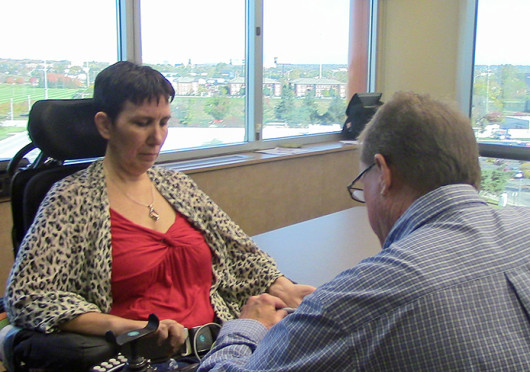
Dr. Jerold Reynolds examines Mary Pat Murry during a checkup Oct. 25 at the Wexner Medical Center Martha Morehouse Medical Plaza.
Credit: Sam Harrington / Lantern photographer
For one Ohio woman, a surgery at the Wexner Medical Center means she can breathe a little easier.
Mary Pat Murry, a 49-year-old resident of London, Ohio, was the Medical Center’s first patient with Lou Gehrig’s disease to receive a diaphragmatic pacemaker this summer.
Lou Gehrig’s disease, or amyotrophic lateral sclerosis, is a fatal disease that attacks motor neurons that connect the brain to muscles. Over time, ALS causes people to lose the ability to move, speak, swallow and breathe. A pacemaker strengthens the diaphragm and allows patients to breathe more easily.
“I have a lot more energy, I can yell at the dogs a lot better … I get hiccups again independently,” she said. “And just breathing, I feel better now. I can tell I’m breathing better.”
Breathing for patients like Murry has traditionally been aided by a cumbersome ventilator, called BiPAP mask, said Dr. Stephen Kolb, a neurologist with the Medical Center, but the mask comes with inconveniences.
“When you’re wearing the (BiPAP) mask, you can’t talk — you can but no one hear you — you can’t drink or eat. With the pacer, I can take care of all that,” Murry said.
The pacemaker allows patients to be able to use the mask less often, but as ALS progresses, the diaphragm will become less and less affected by treatment, even with the diaphragmatic pacemaker. At that point, those affected have to choose between going onto full-time breathing support or not, in which case the patient would die.
Murry, who was a nurse, said knowing the implications of ALS and then being diagnosed with the disease was especially difficult.
“Understanding the disease process is, understanding about losing the muscle and (not) being able to feed yourself, being able to walk, you know, understanding that in a medical way and dealing with it emotional(ly) was hard,” Murry said.
Kolb said the goal of the pacemaker is to provide patients with a high quality of life for as long as possible.
“The hope here is that we just helping breathing and helping comfort, that’s obviously what the goal is, but the ultimate goal is to prolong good quality of life with ALS and this may be a way to do that,” he said.
Murry said she is hopeful the pacemaker will enable her to postpone full-time breathing support for the time being.
“It’s hard to imagine an ALS patient not needing other breathing support full-time. With the pacer, the hope is that that’s further down the road, so the life expectancy will go further,” she said.
After her October checkup, her forced vital capacity, a measurement of how much air can be forcibly exhaled, had increased to 51 percent from 43 percent. While both numbers are significantly lower than the average force capacity, which is about 80 percent, the results show that the pacemaker has helped her.
While the pacemaker is not experimental, more studies need to be done to be able to determine with whom it should be used. The Medical Center is set to be a part of a national study aimed at determining the pacemaker’s use, which is scheduled to start in 2014, said Dr. Jerold Reynolds, a neurologist and level one researcher.
Murry was selected because she was already a patient at the Medical Center and Reynolds felt she was a fitting candidate.
While research is not conclusive, patients that had the BiPAP machine and the pacemaker, in three clinical trials, lived an average of 16 months longer or reached the point where they could choose if they wanted the full-time breathing support, Reynolds said.
“It appears to be very helpful for the quality of life of the patient and hopefully extends the life of the patient, but the disease unfortunately still marches on,” he said.


